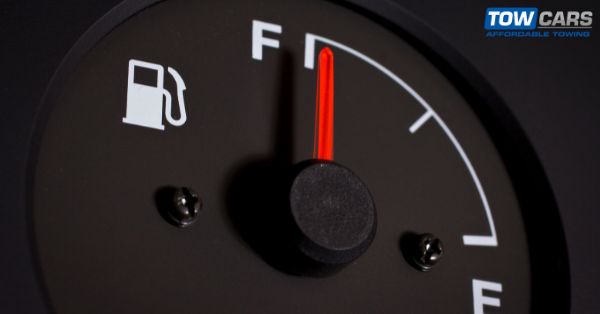Roadside Assistance such as fuel delivery service can help to solve out-of-gas situations. Sometimes an out-of-gas situation may happen due to a faulty fuel gauge. An incorrect fuel gauge is most commonly caused by a malfunctioning fuel sending unit. It measures fuel levels in fuel tanks and communicates those levels to the fuel gauge on the dashboard. A fuel level indicator ensures that the driver knows how much fuel is left in the tank at all times, and when to visit a gas station before the tank is empty. In case of a malfunction, the fuel gauge will be the first to show it, so let’s see how they work together.
How does the fuel sending unit function?
The fuel tank level is measured by the fuel sending unit in the gas tank. Fuel pump sending units may be attached to a fuel pump assembly or stand-alone, but they all consist of the same three components: a float, a metal rod, and a variable resistor. Each of these components measures fuel levels and relays that information to the fuel gauge.
Float – Made of a buoyant composite, the float floats above the fuel in the tank.
Metal rod or arm – The float is connected to the variable resistor by way of a thin metal rod.
Variable resistor – A resistor, also called a variable resistor, is an electrical device that resists the flow of electricity. It is controlled by sliding a contact (wiper) across a resistive element. By wire or indirectly, the wiper is connected to the fuel gauge using an electronic device that communicates with the fuel gauge. A small coil attached to the battery of the vehicle provides power to the variable resistor in the fuel sending unit, which serves as the baseline signal.
How it measures fuel tank levels
If the fuel level changes, the float in the tank will rise or fall. With the metal rod pivoting in relation to the float, the wiper in the variable resistor also moves. Wipers move along strips of material connected to a ground on one end. The strength of the electrical current from the resistor is determined by the location of the wipers to the ground. The fuel level is displayed on the vehicle dashboard based on the electric current sent by the wiper to the fuel gauge.
On the resistive material strip, the wiper is closest to the ground or furthest away when the fuel tank is completely full. The least amount of resistance is found here, while the most resistance is found here. The wiper is either closest to or furthest from the ground when a vehicle is almost out of fuel as the float rests at the bottom of the metal rods. Depending on its specifications, the fuel gauge will show empty or full based on what resistance it reads as empty or full.
Fuel level, as well as the float, drop in the tank, which shifts the metal rod connected to the float to either lower or raise the wiper from the ground, thereby reducing or increasing the amount of electric current reached the fuel gauge. As resistance changes, the fuel gauge display drops from full.
What causes a fuel gauge to not work?
When the fuel gauge acts in a certain way, we may be able to learn what is broken and what needs to be repaired. Below are some indications that the fuel sending unit is faulty and some speculations on why and how the failing fuel sending unit occurred.
1. The gauge fluctuates between empty and full
It is possible for a fuel gauge to display full and empty at the same time because of a mechanical problem. It is possible for the fuel sending unit float arm to “stick” when it reaches a certain level and to fall back into place either smoothly on its own or with vehicle movement. Fuel gauges are accurate again once the float arm is put back into place.
2. The fuel gauge remains on full
In some cases, only reading full on the fuel gauge may be caused by a fuel gauge resistor that always supplies full voltage. When a vehicle uses fuel regularly, the fuel sending unit is constantly in motion, causing the wiper in the variable resistor to move constantly. As a result, the resistive material strip may wear down, resulting in an open circuit. Another possibility is that the connecting wire from the fuel sending unit to the fuel gauge has a defect that causes a shorted signal, or that the ground wire to the grounding terminal is bad. A faulty fuel gauge can also pose a problem, even though it is rare.
3. An empty gauge on a full tank
A fuel gauge that only reads empty is likely caused by a float separation from the arm, causing all other components of the fuel sending unit to shut down. The gauge can also read empty if the signal is completely restricted by a faulty resistor. Damaged wires, especially those on a fuel sending unit located on a fuel pump, can prevent voltage from reaching both the source and the fuel gauge.
Can you ruin your engine by running your gas tank empty?
If the fuel gauge does not work, a vehicle may still be drivable, but not knowing the fuel level puts it at risk of running out of gas. The walk to the gas station isn’t ideal, but running out of fuel isn’t either.
In order to lubricate and cool a fuel pump, the fuel must pass through it. Overheating and damage will occur to the fuel pump when fuel is not available. The fuel pump will fail if a vehicle runs out of fuel constantly.
Vehicles that run on low fuel constantly may accumulate debris from the bottom of the fuel tank that clogs the fuel pump strainer or bypasses the strainer and clogs other components in the fuel system such as the fuel lines and fuel injectors. Fuel system clogs do not just affect performance, but can also affect the longevity of other auto parts or even the engine itself.
Fixing the fuel gauge
Start by checking all of the electrical fuses. A fuse box is usually located under the steering column and another one under the hood of the car. Replace any that are damaged. The cluster may need to be replaced if a problem is found during self-testing of the gas gauge, or if any other lights in the instrument cluster stop working. Inspect the wiring connecting the battery to the gas gauge and the fuel tank. If any wires are damaged, replace them.
All these possibilities fail to solve the issue, then the sending unit is probably at fault (as is most likely the case). Use a bottle of fuel system cleaner first if you notice some corrosion or soiled parts of the sender.
You may need to replace the sending unit if that doesn’t work. It’s difficult to access the fuel tank from the inside, so it’s best left to professionals.
Our Services
- Car Towing
- Van Towing
- Truck Towing
- Emergency Towing
- 24/7 Towing
- Motorcycle Towing
- Cheap Towing
- Old Car Removal
- Junk Car Removal
- Roadside Assistance
- Boat Towing
- Bus Towing
- Clearway Towing
- Accident Towing
- Caravan Towing
- Trailers Towing
- Parking Towing
- 4WD Towing
- Limousine Towing
- Commercial Towing
Give us a call right now! – Click on the number if you are on a mobile 0401 272 229
Tow car service is very close to Patterson Lakes, Victoria 3197, please check below map.
Tow Cars – 24/7 Tow Truck Service – Emergency Towing Melbourne
- Keysborough - 170 Chapel Rd, Keysborough VIC 3173
- Derrimut - 24 Maxwelton Circuit, Derrimut VIC 3030
- Broadmeadows - 5 Holberry St, Broadmeadows VIC 3047
- Hallam - 4/37-41 Hallam S Rd, Hallam VIC 3803


Recent Comments